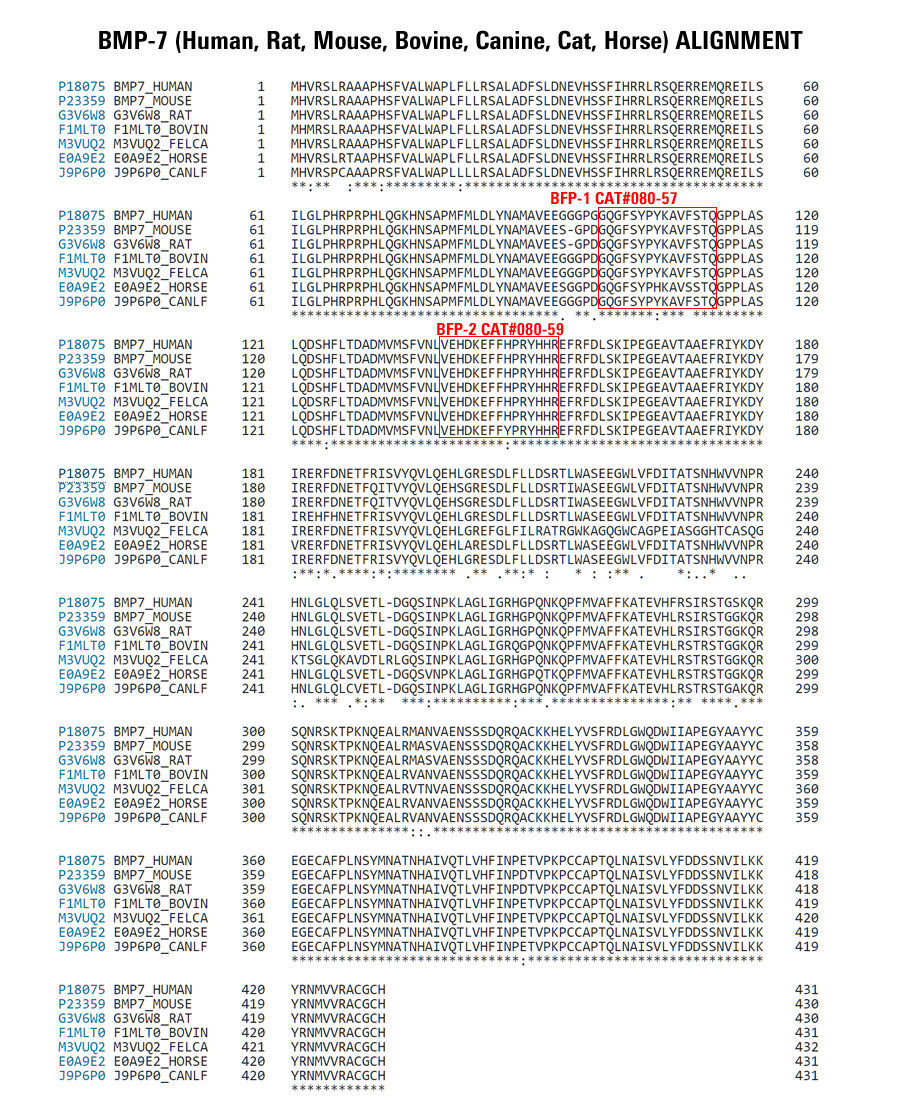
Strategies for efficient osteogenic differentiation and bone formation from stem cells would have clinical applications in treating nonunion fracture healing. Many researchers have attempted to develop adjuvants as specific stimulators of bone formation for therapeutic use in patients with bone resorption. Therefore, development of specific stimulators of bone formation has therapeutic significance in the treatment of osteoporosis. To date, investigations of the mature forms of bone morphogenetic proteins (BMPs) have focused on regulation of bone generation. However, we previously identified new peptides from the immature precursor of BMP, and further analysis of these proteins should be performed. In this study, we identified a new peptide called bone-forming peptide-2 (BFP-2), which has stronger osteogenic differentiation-promoting activity than BMP-7. BFP-2 treatment of multipotent bone marrow stromal cells (BMSCs) induced expression of active alkaline phosphatase. In addition, BFP-2 enhanced CD44 and CD51 expression levels and increased Ca2+ content in BMSCs. Moreover, radiography at 8 weeks revealed that animals that had received transplants of BFP-2-treated BMSCs showed substantially increased bone formation compared with animals that had received BMSCs treated with BMP-7. Our findings indicate that BFP-2 may be useful in the development of adjuvant therapies for bone-related diseases.
Kim HK, Lee JS, Kim JH, et al. Exp Mol Med. 2017;49(5):e328.
Most synthetic polymeric materials currently used for bone tissue engineering lack specific signals through which cells can identify and interact with the surface, resulting in incompatibility and compromised osteogenic activity. Soluble inductive factors also have issues including a short half-live in vivo. Bone forming peptide-1 is a truncated peptide from the immature form of bone morphogenetic protein-7 (BMP-7) that displays higher osteogenic activity than full-length, mature BMP-7. In this study, we used a mussel-inspired immobilization strategy mediated by polymerization of dopamine to introduce recently discovered stimulators of bone forming peptide-1 (BFP-1) onto the surface of poly-lactic-co-glycolic acid (PLGA) substrate to form a biomaterial that overcomes these challenges. Human adipose-derived stem cells (hASCs), being abundant and easy accessible, were used to test the osteogenic activity of BFP-1 and the novel biomaterial. Under osteoinductive conditions, cells treated with both BFP-1 alone and BFP-1-coated biomaterials displayed elevated expression of the osteogenic markers alkaline phosphatase (ALP), osteocalcin (OC), and RUNX2. Furthermore, hASCs associated with poly-dopamine-assisted BFP-1-immobilized PLGA (pDA-BFP-1-PLGA) scaffolds promoted in vivo bone formation in nude mice. Our novel materials may hold great promise for future bone tissue engineering applications.
Li W, Zheng Y, Zhao X, et al. PLoS ONE. 2016;11(3):e0150294.
Osteoporosis is a reduction in skeletal mass due to an imbalance between bone formation and bone resorption. Many researchers have tried to develop adjuvants as specific suppressors of bone resorption and stimulators of bone formation for therapeutic purposes in patients with osteoporosis. Therefore, specific stimulators on bone formation are one of therapeutic significance in the treatment of osteoporosis. Until now, the regulation of bone generation has been the focus of bone morphogenetic protein-7 (BMP-7) investigation from mature form. However, new peptides from immature form which has osteogenic activity has not been reported and developments of these proteins are still remained. In this study, we found a new peptide sequence, called bone forming peptide-1 (BFP-1) and have more high activities of osteogenic differentiation compared with BMP-7. BFP-1-treated multipotent bone marrow stromal stem cells (MBSCs) induced the expression levels and activity of alkaline phosphatase (ALP). Moreover, BFP-1 enhanced the levels of CD44, CD47 and CD51 expression as well as increased Ca(2+) content in MBSCs. In current study, radiography at 8 weeks revealed that BFP-1 pretreated-MBSC transplanted animals had strongly increased bone formation compared to that in the BMP-7 pretreated MBSC transplanted animals. Our finding indicates a new insight into peptides from the immature region of BMP-7 can also be useful in the development of adjuvant therapies for bone-related diseases.
Kim HK, Kim JH, Park DS, et al. Biomaterials. 2012;33(29):7057-63.
| Catalog# | Product | Standard Size | Price |
|---|---|---|---|
| 080-06A | BMP-4, recombinant (Human) | 5 µg | $236 |
| 080-57 | Bone Forming Peptide 1 (BFP-1) (Human, Rat, Mouse, Bovine, Feline) | 100 µg | $186 |
| 080-59 | Bone Forming Peptide 2 (BFP-2) (Human, Rat, Mouse, Bovine, Feline) | 100 µg | $186 |
Social Network Confirmation